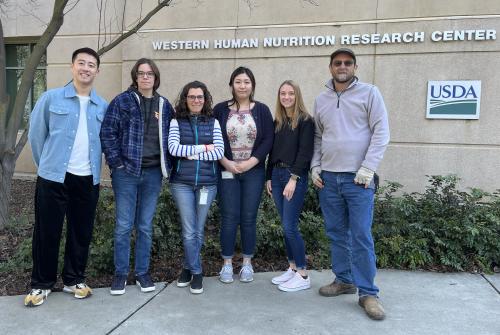
The laboratory of Dr. John W. Newman will offer advanced metabolomics services and development in the area of lipid mediators and lipoprotein particle isolation and metabolomics. The Newman laboratory is part of the US Department of Agriculture, Agricultural Research Service, Western Human Nutrition Research Center (WHNRC) Obesity and Metabolism Research Unit. The mission of this laboratory is to enhance our understanding of how food and nutrition can prevent and influence obesity and its co-morbidities. Lipids not only represent a significant component of an individuals’ caloric intake, but also represent building blocks and substrates for a variety of biochemical processes critical for the maintenance of health and response to disease. Quantitative analyses of lipids and lipid mediators are supported in multiple core labs. The Newman laboratory has established numerous quantitative targeted assays to the study of human nutrition, and is a world leader in the development of protocols to measure the distribution of bioactive lipid mediators within esterified lipid pools. Currently, the laboratory quantifies non-esterified fatty acids, oxylipins, endocannabinoids, and sphingoid bases, as well as esterified oxylipins and fatty acids using a combination of GC-MS and UPLC-MS/MS.

Fatty Acid and Oxylipin Compartmentalization
Fatty acids their oxygenated bioactive metabolites (ie. oxylipins) exist in both esterified and non-esterified forms within the body. While much is known regarding the physiological implications of the free oxylipins, the role of the esterified pools in health and disease remain to be explored. Over the past several years we have optimized procedures allowing the isolation and quantitative determine of oxylipins and their parent fatty acids in cholesterol esters, triglycerides, phospholipids, and non-esterified pools in a single sample extract. For example, using these techniques, we have found that the polyunsaturated fatty acid content of the diet diffrerentially alter the oxylipin profiles of adipose triglycerides and cholesterol ester pools.
Fatty Acid and Oxylipin Distribution Among Lipoprotein Particles
Lipids and other hydrophobic chemicals within the circulatory compartment are distributed into various soluble sub-compartments. While compounds associated with albumin are available to tissues through passive diffusion, components within lipoprotein particles are delivered to tissues through enzymatic and receptor mediated processes. While alteration in lipoprotein structure and function have been associated with an elevated risk of cardiovascular disease, the role shifts in small molecule composition has on the mechanisms of this association are still hypothetical.
We have found that using gel-permeation chromatography of 100-150µL of plasma, lipoprotein particles can be isolated providing sufficient material for targeted analysis of lipid mediator content. For instance, in a study investigating the impact of omega-3 fatty acid supplementation on lipoprotein oxylipin profiles, we found that while very low density lipoprotein particles (VLDL) were in reached in DHA and EPA epoxides and diols, the LDL particles were enriched in EPA but not DHA metabolites
We will advance the analysis and biological interpretation of lipid mediators:
- We will transfer or lipid subclass solid phase fractionation procedure onto a 96-well robotic sample handling platform to increase sample throughput, and thus reduce the cost of these assays.
- We will establish a UPLC-MS/MS-based bile acid quantification analysis.
- We will establish reduced analyte sub-routines and transfer these into the Centeral Services Core where they can be used as efficient screening tools in hypothesis generation. Where possible (e.g. oxylipins and endocannabinoids) positive and negative ionization mode assays will be combined.
- We will work together with the Gaikwad, Fiehn and Hammock laboratories to improve data processing strategies, including in-filling of missing values.
- We will develop and expand assays in support of research focused on the investigation the impacts of foods and nutritional status on health.
Equipment
AB Sciex 6500 QTRAP mass spectrometer with Shimadzu UPLC
AB Sciex QTRAP 4000 mass spectrometer with Waters UPLC
Waters Quattro Micro MS/MS with Waters 2695 Alliance HPLC
Agilent 5977 MSD with a 7890 GC with SIM/SCAN and backflush capability
Agilent 5973 MSD-N with a 6890N GC with SIM/SCAN and backflush capability
Waters 626 HPLC with a 717 Autosampler, 996 PDA detector, and Frac-200 fraction collector
Staff
John W. Newman, PhD - Director (Research Chemist USDA, ARS, WHNRC, Obesity and Metabolism Research Unit & Adj. Professor, Dept. of Nutrition, UC Davis; John.Newman2@usda.gov; (530)574-9252)
Isabel Snodgrass, PhD - Laboratory Manager (Assistant Project Scientist, Genome Center, UC Davis; irfaria@ucdavis.edu)
Kamil Borkowski, PhD – Special Projects Lead (Assistant Project Scientist, Genome Center, UC Davis; kborkowski@ucdavis.edu)
Nuanyi Liang, PhD - Lipidomics of Alzheimer's Disease (Postdoc, Genome Center, UC Davis; nyliang@ucdavis.edu)
Danielle Caruso, BS - Laboratory Support Technician (Staff Research Associate I, Genome Center, UC Davis; djcaruso@ucdavis.edu)
Mengjiang (Troy) Huang , BS, MS, - Nutritional metabolomics research (Graduate Student Researcher, PhD Candidate - Graduate Group in Nutritional Biology, UC Davis; mjthuang@ucdavis.edu)
Relationship USDA - Newman laboratory to UC Davis
This effort is an official collaboration between the United States Department of Agriculture and the University of California Davis. The interaction is authorized under ARS Agreement 58-2032-8-023-N a subordinate project to USDA CRIS Project 2032‑51530‑025‑00D Improving Public Health by Understanding Diversity in Diet, Body, and Brain Interactions
2032-51530-025-00D - Improving Public Health by Understanding Metabolic and Bio-behavioral Effects of Following Recommendations in the Dietary Guidelines for Americans
